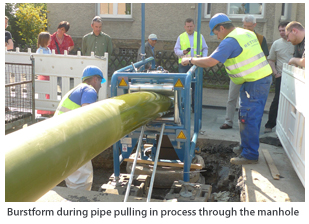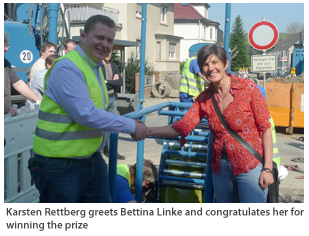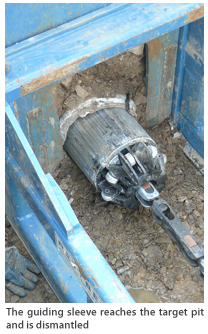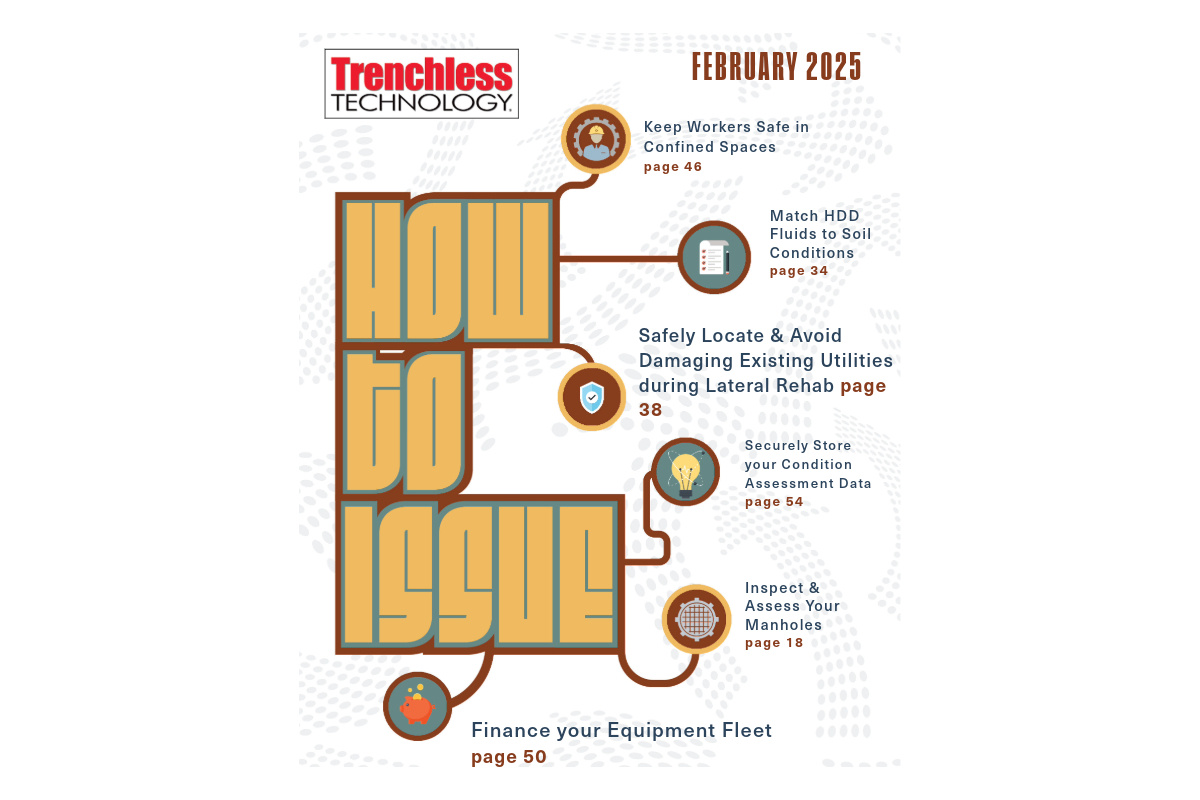Hagen’s Urban Drainage Council Wins a Construction Measure
July 27, 2011
 You don’t win a construction measure everyday, but Bettina Linke from the Urban Drainage Council in Hagen, Germany, was the lucky winner of one.
You don’t win a construction measure everyday, but Bettina Linke from the Urban Drainage Council in Hagen, Germany, was the lucky winner of one.“I really didn’t expect this and was totally surprised,” Linke said.
As a contestant of the fourth German Symposium for trenchless pipe renewals at the University of Siegen,
she took part in a competition and promptly won “the big prize” for her employers. Although she didn’t have any personal gain from this, she was still extremely pleased with her success.
The prize included a trenchless renewal of a sewage pipe using the TIP method and applying the Burstform unit.
In doing so, PE pipes are welded together to form a complete pipe length and pulled into the old pipe via a revision manhole with a diameter of 1 m. In order to carry this out, the pipe has to be formed into an oval shape. Immediately before entering the old pipe, it is then returned into its original circular form and continuously pulled in. The guiding sleeve, which runs ahead of the new pipe and is held centrally by guiding rollers, evens out any deformations. The pipe is then lying very tight to the old pipe wall and this makes sure that the cross-section is decreased as minimally as possible. TIP is the short form for Tight in Pipe.
At the end of April, the prize was converted into the true installation measure. The company Rettberg GmbH & Co. KG from Göttingen, together with TRACTO-TECHNIK, Lennestadt, sponsor of the prize and promoter for the Symposium in Siegen, were responsible for the task. Two lengths on the Hülsdorfer Street in Hagen that were more than 52 m and 57 m length were due for renewal. Of the nine house connections, four were connected centrally in the machine pit using open trenching and five connections carried out with the trenchless method, using a sanitation robot from Hächler.
The old pipe, situated at a depth of 2.10 m and made of concrete ND 300 had several displacements and deformations over the whole length. The single pipes from Schöngen PE 100 RC 292 x 13 mm, each of 6-m lengths were welded together beforehand to complete a 52-m pipe length.
First of all, an emergency disposal and cleaning process for the old pipe had to be arranged. In the middle of the total installation length, a pit was set up and the Grundoburst 400 S bore rig was installed. With this hydraulically operated rig the QuickLock bursting rods could be pushed in both directions for the installation of the new pipe.
Afterward the Burstform and the roller guidance system were installed inside the manhole. The pipe length connected to the QuickLock bursting rods was then pulled through the roller guiding system, giving the pipe its oval shape. In the shaft – on the level of the old pipe – the PE-pipe carries out a 90-degree curve in the tightest space. Then a reverse forming device brings the pipe back to its original circular form and pulls it through the guiding sleeve.
The forming process for the pipe allows a higher curve access and easier handling.
The special PE 100 RC pipe material according to PAS 1075 makes sure that the material does not lose any of its structure.
 The pipe lengths without sockets, made of PE plastic have much lower hydraulic correction values than concrete pipes of the same diameter. “The necessary flow capacity is therefore still retained even if the cross-section of the pipe is slightly reduced,” according to Dipl.-Ing. Karsten Rettberg, managing director of the same company.
The pipe lengths without sockets, made of PE plastic have much lower hydraulic correction values than concrete pipes of the same diameter. “The necessary flow capacity is therefore still retained even if the cross-section of the pipe is slightly reduced,” according to Dipl.-Ing. Karsten Rettberg, managing director of the same company. There was great interest from the numerous sewage experts from neighboring towns, who had received invitations from Linke. Before Rettberg gave the go-ahead to start the pipe installation, he explained the construction measure to all the watching participants. The pipe pulling-in process was completed after one hour. The setup times took a little longer, approximately 1.5 working days. All the participants seemed to be completely satisfied, as this method showed that the pipe to be renewed could be replaced by a fully intact new pipe relatively quickly and at a low cost and an almost constant even amount of hydraulic power in a trenchless manner.
Method advantages:
Installation of sewage new pipes as long pipes, length up to 100 metres: Trenchless – socketless
- Pipe installation, generally from a starting manhole Ø 1 m to a machine pit
- Pipe material PE 100 RC and pipe diameters from OD 192, 242 and OD 292,
Before entering the old pipe the plastic pipe is brought back into it’s original circular form and pulled in Tight.
.
Tight in pipe means only slight cross-section loss. The hydraulic performance remains intact
or is compensated by the lower hydraulic correction values.
The material characteristics of the plastic pipe are not influenced by the forming process.
 The pipe installation is also possible by pipe-cracking, therefore the new pipe can be larger than the old pipe – larger pulling in shafts are not required
The pipe installation is also possible by pipe-cracking, therefore the new pipe can be larger than the old pipe – larger pulling in shafts are not requiredDuring the pipe installation no personnel is situated in the revision manhole
House connections can be connected underground.
Short construction times
Constructional advantages
Applicable with existing pipes, therefore especially recommended in inner-city areas
Selective jobsite due to small target pit: Pipe sole + working area
One target pit for two lengths in opposite directions, each over 100 m length
No road-blocks, diversions, narrow roads
No trouble with residents and shop owners
– no excavation, no road disruption and no road repair work
Cost saving due to short construction times and reduction of civil engineering work.
This article was supplied by TRACTO-TECHNIK GmbH & Co . KG, Lennestadt, Germany.




